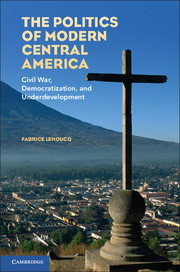Book contents
- Frontmatter
- Contents
- Figures
- Tables
- Introduction
- 1 Central America on the Eve of the 1980s
- 2 Civil War, Revolution, and Economic Collapse
- 3 Stalemates, Peace Negotiations, and Democratization
- 4 Economic Stability, Lackluster Growth, and Social Change
- 5 Democratization, State Capacity, and Redistribution
- Conclusion
- Bibliography
- Index
5 - Democratization, State Capacity, and Redistribution
Published online by Cambridge University Press: 05 September 2012
- Frontmatter
- Contents
- Figures
- Tables
- Introduction
- 1 Central America on the Eve of the 1980s
- 2 Civil War, Revolution, and Economic Collapse
- 3 Stalemates, Peace Negotiations, and Democratization
- 4 Economic Stability, Lackluster Growth, and Social Change
- 5 Democratization, State Capacity, and Redistribution
- Conclusion
- Bibliography
- Index
Summary
Introduction
Military governments no longer rule the isthmus. Citizens elect presidents, legislators, and municipal councilmen in each country of the region. This perhaps is the single most important conquest of the civil wars of the 1970s and 1980s. It was a hopeful outcome, and not only because overthrowing dictatorship was a central goal of so many who died in the region’s violent conflicts.
Have elections made a difference? There are good reasons to believe that they should. Parties offer different platforms in exchange for votes, and the party or parties that win elections then convert these preferences into laws. This is the virtuous circle of accountability that democratization should unleash. In the context of underdeveloped societies with legions of poor voters, competitive elections should increase redistribution and social spending. Democracy, in other words, should placate the majority and promote the common good.
The goal of this chapter is to explain why this question cannot be easily answered in the affirmative. Although elections have met minimal standards of openness and fairness, clashes between presidents and other branches of government have tainted the quality of the region’s democratic institutions. They have led to conl icts in which executives sometimes have prevailed and other times have been exiled. So, even while democracy remains consolidated in Costa Rica and has become stronger in Panama and El Salvador, it has fused with some blatantly autocratic elements in the other republics of the isthmus. A blemished political record bodes poorly for the functioning of democratic institutions, effects that I document and explain in this chapter.
- Type
- Chapter
- Information
- The Politics of Modern Central AmericaCivil War, Democratization, and Underdevelopment, pp. 118 - 151Publisher: Cambridge University PressPrint publication year: 2012

